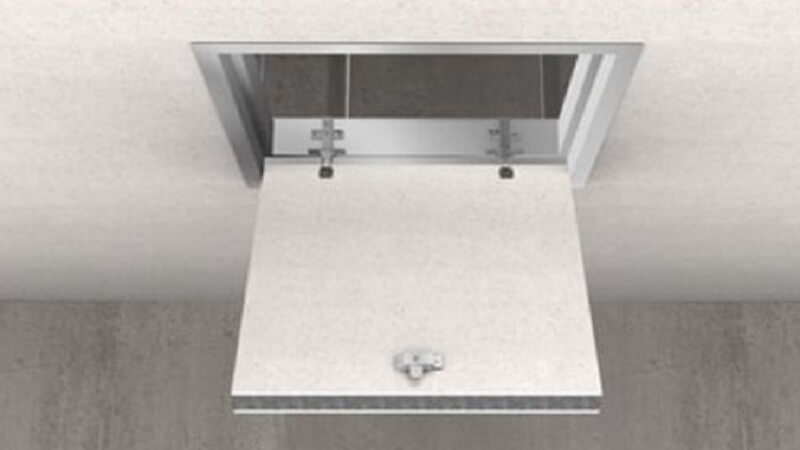Ceiling access doors are a standard feature in nearly every modern building, providing essential access to utilities and maintenance areas. Despite their prevalence, they often go unnoticed in interior design.
This article explores how you can seamlessly integrate ceiling access doors into modern interiors, enhancing functionality and aesthetics.
What Are Ceiling Access Doors?
Ceiling access doors are concealed openings in ceilings that provide access to hidden spaces above. These areas typically contain plumbing, electrical wiring, HVAC systems, and other essential equipment. Ceiling access doors offer a discreet and convenient way to reach these utilities for maintenance or repairs.
There are several types of ceiling access doors available to suit different needs and preferences:
- Flush Access Panels: Flush access panels, like the GFRG-R ceiling access door, blend seamlessly with the surrounding ceiling surface, creating a clean and discreet appearance. They are ideal in settings where aesthetics is a priority.
- Recessed Access Doors: Recessed access doors are set slightly below the ceiling, creating a subtle indentation. They work well in modern interiors with clean lines and uncluttered spaces.
- Fire-Rated Access Doors: These entry points meet fire safety standards. They provide a barrier to slow the spread of flames and smoke for a limited duration. They are commonly used in multi-family residences, commercial spaces, and industrial facilities.
- Security Access Doors: These ceiling access doors have enhanced security features—locks, reinforced frames, tamper-resistant latches, and concealed hinges—to protect against unauthorized access. They suit high-security areas where protecting sensitive equipment and information is essential.
Benefits of Ceiling Access Doors
Ceiling access doors offer numerous benefits that make them an asset in any residential or commercial building:
- Enhanced Interior Appearance: Flush and recessed access doors can be seamlessly incorporated into the ceiling, creating a clean and polished look. They eliminate the need for unsightly access hatches or drop ceilings.
- Improved Accessibility: Ceiling access doors provide easy access to the area above the ceiling. They facilitate efficient maintenance and repairs without needing extensive demolition or disruption.
- Increased Safety: Fire-rated access doors help to contain fires and limit the spread of smoke for a certain duration, protecting occupants and property. Meanwhile, security access doors deter unauthorized access, safeguarding valuable equipment and sensitive information.
- Greater Convenience: Ceiling access doors simplify routine tasks like changing light fixtures, cleaning air ducts, and inspecting insulation. They eliminate the hassle of accessing these components through other means, such as cutting holes in the ceiling.
Aesthetic Considerations
When selecting ceiling access doors, it’s important to consider how they will blend with the space’s overall aesthetic. Here are some factors to keep in mind:
Blending With the Interior
Ceiling access doors come in various styles, allowing you to find the perfect match for any interior design. Flush access panels, with their clean and understated design, are ideal for minimalist spaces.
Meanwhile, recessed access doors can complement traditional interiors, making the room look and feel more luxurious. Contemporary spaces, on the other hand, may benefit from sleek, modern designs with metallic finishes.
Choosing Suitable Materials
The ceiling access door’s material can affect its appearance and durability. Steel and stainless steel are popular for their strength and durability. They offer a classic, industrial look that suits modern or contemporary interiors.
Aluminum is another lightweight and durable option often used in commercial settings. Glass fiber reinforced gypsum panels are a recent innovation offering a lightweight and customizable solution.
Selecting Colors and Finishes
Color and finish are essential in enhancing the appearance of ceiling access doors. Neutral colors like white, gray, or black can create a clean look. Brighter colors can add character to a space.
The finish can also impact the ceiling access door’s appearance. Matte finishes create a more subdued look, while glossy finishes can provide a touch of sophistication.
Exploring Customization Options
Many ceiling access door manufacturers offer customization options for a unique and personalized design. You can choose from a range of sizes, shapes, and configurations. Additionally, you can select custom colors, finishes, and hardware to match your design preferences.
Integrating Ceiling Access Doors Into Interior Design
Ceiling access doors don’t have to be an eyesore. With creativity and careful planning, you can seamlessly integrate them into the interior decor:
Placement and Location
Ceiling access doors should be placed near essential utilities. However, strategic placement is crucial for minimizing its visual impact. If possible, install them in less prominent areas, such as corners or near walls. In larger spaces, align them with existing architectural features like beams or soffits to create a cohesive look.
Camouflage Techniques
Get creative with disguising the ceiling access doors. Consider integrating them into decorative ceiling patterns or textures. Custom-painted panels that match the surrounding ceiling can create a nearly invisible effect. For a bold approach, transform the access door into a focal point with artistic designs or incorporate it into a larger decorative element.
Lighting and Shadows
Clever use of lighting can effectively mask ceiling access doors. Install recessed lighting fixtures nearby to draw attention away from the door. Alternatively, use directional lighting to cast subtle shadows that help the access door blend into its surroundings. This approach conceals the access door and adds depth and ambiance to the room.
Conclusion
Often overlooked in interior design, ceiling access doors can enhance functionality and aesthetics. Considering factors like placement, materials, color, and customization options can help you seamlessly integrate these essential features into any modern space.
Remember, functional design doesn’t have to compromise on style. With the right approach, ceiling access doors can be a stylish addition to a residential or commercial space.
